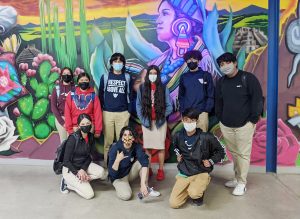
by Karen Johnson, Communications Director, College of Computing
Through the leadership of the Detroit Hispanic Development Corporation (DHDC), with Michigan Tech and Ford, eight students from César Chávez Academy High School, Detroit, Mich., completed an online section of CS1121, Introduction to Programming I, in fall 2021. Dual-enrolled, the students earned academic credit from both Michigan Tech and the Academy.
“I was delighted when we were asked to work with DHDC,” says Dr. Linda Ott, chair of Michigan Tech’s Department of Computer Science. “It’s always rewarding to participate in outreach that provides high school students a chance to discover their passion for computing. It opens a world of opportunities for them. Students who are exposed to programming in high school are much more likely to pursue a degree in computer science or software engineering.”
The students met daily, attending live online lectures instructed by Department of Computer Science assistant professor Briana Bettin, and live online lab sessions conducted by Michigan Tech students. The DHDC transported the students from the Academy to the DHDC, provided classroom space for the lectures and associated labs, and offered many other forms of student support.
Audiovisual equipment—webcams and headphone sets—was donated by the Michigan Tech College of Computing, and Ford covered half the cost of the students’ tuition. The remaining tuition was provided by the César Chávez Academy.
The response from the Academy students has been enthusiastic. “The students really opened up, chatting and joking, as well as asking insightful questions and engaging with the lecture even while remote,” says Bettin. “They were excited and vibrant, and I felt like I had become ‘part of a club’ as they started to open up and share their energy and their personalities with me.”
“Dr. Bri is an amazing instructor. She was the perfect choice for this program,” says Leah Goodwin, Director of STEM Education and Career Pathways at the DHDC. “I can’t tell you how pleased I’ve been with MTU’s willingness to accommodate our needs.”
“I was grateful to make it possible for these students to actually take a CS program through a university that’s ranked number one some lists,” says Goodwin. “That was huge. It really made it relevant and impactful for the students.”
The Academy Students
In the spring 2022 semester, three of the Academy students continued to the next course in the sequence, CS1122 Introduction to Programming II, again dual-enrolled at Michigan Tech. All three (Arnold Contreras, Yahir Corona-Martinez, and Jax Lugo-Rivera) have applied and been accepted to begin their undergraduate studies at Michigan Tech in fall 2022.
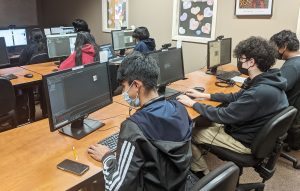
Jax Lugo-Rivera has always been interested in computer science, and after completing an introductory computer programming class their sophomore year of high school, their interest grew. “I really like the ability to create things from nothing,” they say of computer science. “I like being able to get all these ones and zeros together and create something.”
“I like the problem-solving aspects of computer science,” adds Corona-Martinez. “That is really interesting for me. I also like the collaborative aspect of computer science and sharing ideas with one another.”
The three Academy students agree that it’s important to complete a bachelor’s degree. Corona-Martinez wants to keep learning and building his skills. Contreras wants to be the first in his family to do complete a college degree. And Lugo-Rivera wants to make sure they’re able to get a stable job and avoid financial worries.
“Just getting a job after high school doesn’t feel right for me,” says Contreras. “Going to college and then getting a job suits me better.”
The Michigan Tech courses aren’t easy, and the students have had challenges to overcome. “Sometimes, the concepts would be a bit difficult, but I would make the effort to watch a YouTube video or read additional documentation about how the code works,” says Corona-Martinez. “That would help me to do better.”
“Watching and taking notes from the lectures wasn’t enough,” agrees Contreras. “I definitely have to take some time on my own to look back on the lectures, find some practice problems, and watch YouTube videos.”
The Academy students are grateful for the support of the DHDC and Leah Goodwin. “The DHDC and Leah allowed us to full-on take the course on a schedule that we can all manage,” says Corona-Martinez
A Passion for STEM Education
Leah Goodwin began teaching high school science in the Detroit area in 2008, and it wasn’t long before she was motivated to identify and arrange additional STEM opportunities for her students.
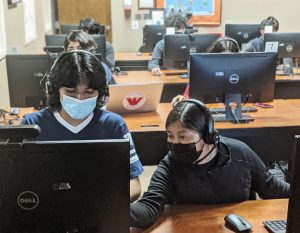
In the 2010s, Goodwin started a robotics team at César Chávez Academy High School, which helped inspire the start of more teams. Today the DHDC coordinates 12 FIRST Robotics teams in the Detroit area. It was the formation of these teams led to the beginning of DHDC’s relationship with Michigan Tech. MTU’s Summer Youth Program has provided scholarships for Detroit-area students to attend the SYP camps since the mid-2010s. (https://www.firstinspires.org/, https://www.mtu.edu/syp/)
“STEM programming has always been part of my career as an educator,” Goodwin notes. “And this neighborhood, in particular, has been my area of focus. To know these students is to love them. They’re so eager and so respectful and grateful for the opportunities. It really makes it rewarding.”
Help from Ford
In 2019, Goodwin channeled some of her passion to apply for a grant from Ford, proposing that the DHDC become an adjunct STEM educational facility to offer science, technology, engineering, and math courses through student dual-enrollment.
“Teaching shortages exist, so we can’t just credential teachers to teach these classes,” Goodwin notes. “The idea was that, since we are a community non-profit facility, we should be able to bring our programming to a broader audience through facilitating the college classes.”
The Ford grant was awarded, with a request from the company to focus on computer science outreach. Goodwin began reaching out to area colleges, connecting with Michigan Tech through the DHDC’s already-established relationship with MTU’s Summer Youth Program.
The Learning Lab Instructors
Michigan Tech Computer Science Ph.D. student Kieran Young led the learning lab for the class. “Kieran absolutely rocked working with the students, but it was clear he could benefit from having some extra hands on deck,” says Bettin. “We were able to bring in two amazing undergrad assistants, Marie Zgurich and Katie Ulinski, to be lab assistants for these students.”
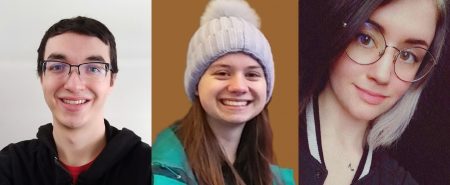
“This was my first real teaching-type experience, so I learned a lot about how to teach high school students,” says Young. “Young students, in general, seem to need time to open up and feel comfortable. So, for example, students wouldn’t always ask for help when they needed it.”
Katie Ulinski, who is majoring in Psychology and Human Factors with a concentration in Human-Computer Interface Design, is also pursuing a minor in Computer Science. “I was impressed with the motivation of the high school students,” she says. “Some days, like all students, they needed some nudging to get their work done. But they always surprised me by how much they could get done. Helping with the labs showed me how different people approach the same problem, something that I am interested in within the subject of human factors.”
“Helping out with the class was a great opportunity and the students were awesome,” Ulinski adds. “It always made me happy to see how excited they were when they got a program to run correctly. It also made me happy to hear that a few of them are thinking about coming to MTU once they graduate.”
Marie Zgurich, a Software Engineering major, found that helping with the lab was a learning experience for the teacher as much as it is for the student. “Seeing how students grow and figure things out taught me a lot about effectively conveying information to different audiences,” she says. “I was impressed by how quickly many of the students were picking up the material.”
Scaffolding the College Experience
“We want the students to get the real college experience, but we know that we can’t just throw them in. We don’t want to set them up for failure,” says Goodwin. “We want to make sure that we’re scaffolding the college experience and really easing that transition. That’s the whole point of dual enrollment. You’re not just sending them off to college. They get this kind of middle area to help them acclimate before they’re actually off on their own.”
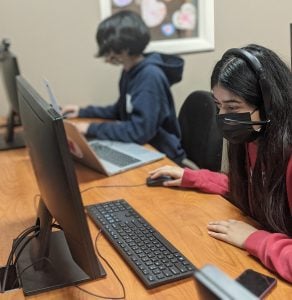
Additional forms of student support are offered through the DHDC’s STEM Education and Career Exploration Initiative. For instance, a weekly Clubhouse to Career program, a chapter of The Clubhouse Network, arranges campus tours and job shadows and assists the youth with resume building, financial aid and FAFSA applications, and scholarship essays.
A student mentorship program has also been established, engaging a cadre of Ford professionals and Eastern Michigan University graduate students in one-on-one mentoring to encourage and assist the students.
Further, the DHDC employs a college access and success coordinator, funded through the Jacob Family Foundation, who has weekly one-on-one check-ins with the students to make sure that they’re on track to navigate the college application and enrollment process.
“It’s nice to be able to pool all these resources. We’re accomplishing the same goal, but every grant has a specific purpose. It’s great when several different funding sources can support all the aspects of a program,” says Goodwin of the many organizations that make this programming possible.
A Special Visit
Bettin visited the Academy students during Week 8 of the semester. “I was able to tour their high school, ride back with them to DHDC, help them out and answer questions about college during their class session, and even go on a trip with a few of them to a Cider Mill on Saturday to spend a bit more time getting to know them!”
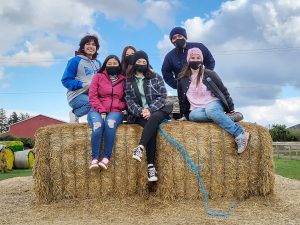
“It shouldn’t have been, but it was surprising to me that knowledge of rural life isn’t just “common knowledge,” says Bettin of the field trip and student reactions to the cider mill. “I take for granted that I know things like how to get an animal to approach you, how big pigs get, or what baling hay is. Visiting the cider mill with the students was eye-opening to me for just how different concepts of the world can be even when you’re located in the same state or geographical region.”
“I marveled as the students shared with me about their neighborhood and their school, and their day-to-day experiences that were so different from mine,” Bettin reflects. “In the same way, they marveled as I described how baling hay is a common summer job out on the farms, and what that job entails. The way the field trip let me share things ‘from my world’ with them, just as they were sharing with me things ‘from their world,’ was so unexpected and wonderful. It wasn’t a computer science learning moment—it was a human learning moment.”
Diversity in Computing and STEM
In her research, Bettin is intrigued by how we communicate in a sociotechnical society, both about and with technology. To that end, she says, it’s essential to understand the experiences of all different types of learners as they engage in learning about technology.
“We live in an increasingly technological society, and its impacts affect everyone. Far too much technology is developed without consideration of the real experiences and needs of those who aren’t present in the room,” says Bettin. “Even more concerning, technologies that don’t account for diverse lived experiences can end up with very personal, real, and devastating impacts. When a development team lacks diverse perspectives, they’re unlikely to recognize these major potential pitfalls.”
“Creating more diverse teams—teams that bring in more diverse perspectives—encourages building better solutions,” Bettin adds. “These solutions take into account cases that would have gone unnoticed by a team without that perspective, and this tends to result in a more innovative and objectively better outcome at launch. We need different perspectives and different approaches when designing solutions, to reach for something better.”
Bigger and Better
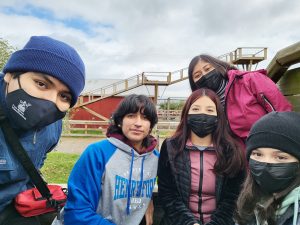
The DHDC continues to expand its Computer Science and STEM programming. This spring Goodwin is teaching two sections of the class, Computer Science Discoveries, at César Chávez Academy Middle School to assist in feeding this pipeline. Next year, in addition to continuing the STEM outreach programs in Detroit Public Schools, she‘ll be working to engage more high schools.
“College graduates with a computer science degree have a world of opportunities available to them,” says Ott. “Whether graduates want to live in southeast Michigan, elsewhere in the U.S., or around the world, the diversity of career opportunities is astounding. There is a huge demand for software engineers in the automotive industry, and a wide range of other industries.”
Cesar Chavez Academy
César Chávez Academy has an enrollment of approximately 1,650 students in grades K through 12 with 600 of those in the high school, 600 in the middle school, and approximately 450 in the grade school. The mission of the school is to be the top urban-based school district in the country as evidenced through motivated and prepared instruction, a disciplined learning environment, and a commitment to providing students with all of the many tools, resources, and educational experiences that they will need to be successful in life. (https://www.chavezacademy.com/)
The Detroit Hispanic Development Corporation
DHDC’s mission is to make a difference by creating life-changing opportunities for youth and their families. We are committed to meeting the needs of our community by providing quality, innovative, and culturally appropriate services, primarily in Southwest Detroit. The DHDC’s vision is to create a stable and safe community where youth and families have quality opportunities for self-empowerment, education, and personal wealth.
The Department of Computer Science
With over 500 undergraduates and 75 graduate students, the Department of Computer Science offers B.S., M.S., and Ph.D. degree programs in computer science, cybersecurity, data science, and software engineering. Students in CS programs enjoy a wide range of opportunities to enhance their classroom learning through participating on research teams with faculty, developing software as part of a student enterprise (for everything from video games to satellites to developing citizen science projects) to participating in programming and cybersecurity competitions and completing internships. Computer Science department research spans the computing field from the design of more efficient processors to the development of technologies to enhance the capabilities of users with disabilities. CS research projects study cloud computing, cybersecurity, virtual environments, software engineering, algorithms, education, artificial intelligence, and data science.
The College of Computing
The mission of the College of Computing is, “to advance the transformational promise of computing in the service of society through excellence in teaching, research, and outreach.” Our vision is, “to be the premier provider of computing talent and innovation to Michigan and the Great Lakes region.” The College serves 700 students through undergraduate and graduate programs in two academic departments dedicated to Computer Science and Applied Computing. The College’s bachelor’s, master’s, and Ph.D. degree programs include Computer Network and System Administration, Computer Science, Cybersecurity, Data Science, Electrical Engineering Technology, Health Informatics, Mechatronics, Software Engineering, and affiliated programs.
Michigan Technological University
Michigan Technological University is a public research university founded in 1885 in Houghton, Michigan, and is home to more than 7,000 students from 55 countries around the world. Consistently ranked among the best universities in the country for return on investment, the University offers more than 125 undergraduate and graduate degree programs in science and technology, engineering, computing, forestry, business and economics, health professions, humanities, mathematics, social sciences, and the arts. The rural campus is situated just miles from Lake Superior in Michigan’s Upper Peninsula, offering year-round opportunities for outdoor adventure.